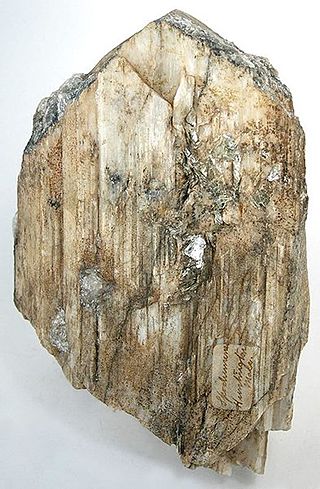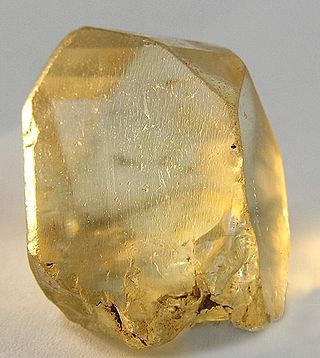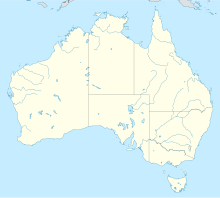
Lithium is a chemical element; it has symbol Li and atomic number 3. It is a soft, silvery-white alkali metal. Under standard conditions, it is the least dense metal and the least dense solid element. Like all alkali metals, lithium is highly reactive and flammable, and must be stored in vacuum, inert atmosphere, or inert liquid such as purified kerosene or mineral oil. It exhibits a metallic luster. It corrodes quickly in air to a dull silvery gray, then black tarnish. It does not occur freely in nature, but occurs mainly as pegmatitic minerals, which were once the main source of lithium. Due to its solubility as an ion, it is present in ocean water and is commonly obtained from brines. Lithium metal is isolated electrolytically from a mixture of lithium chloride and potassium chloride.

A pegmatite is an igneous rock showing a very coarse texture, with large interlocking crystals usually greater in size than 1 cm (0.4 in) and sometimes greater than 1 meter (3 ft). Most pegmatites are composed of quartz, feldspar, and mica, having a similar silicic composition to granite. However, rarer intermediate composition and mafic pegmatites are known.

Spodumene is a pyroxene mineral consisting of lithium aluminium inosilicate, LiAl(SiO3)2, and is a commercially important source of lithium. It occurs as colorless to yellowish, purplish, or lilac kunzite (see below), yellowish-green or emerald-green hiddenite, prismatic crystals, often of great size. Single crystals of 14.3 m (47 ft) in size are reported from the Black Hills of South Dakota, United States.

Rum Jungle or Unrungkoolpum is a locality in the Northern Territory of Australia, about 105 kilometres south of Darwin on the East Branch of the Finniss River. It is 10 kilometres west of Batchelor and shares a boundary with Litchfield National Park.

Mining in Western Australia, together with the petroleum industry in the state, accounted for 94% of the State's and 46% of Australia's income from total merchandise exports in 2019–20. The state of Western Australia hosted 123 predominantly higher-value and export-oriented mining projects and hundreds of smaller quarries and mines. The principal projects produced more than 99 per cent of the industry's total sales value.

The mining of minerals in Nigeria accounts for only 0.3% of its gross domestic product, due to the influence of its vast oil resources. The domestic mining industry is underdeveloped, leading to Nigeria having to import minerals that it could produce domestically, such as salt or iron ore. The rights to ownership of mineral resources is held by the Federal Government of Nigeria, which grants titles to organizations to explore, mine, and sell mineral resources. Organized mining began in 1903, when the Mineral Survey of the Northern Protectorates was created by the British colonial government. A year later, the Mineral Survey of the Southern Protectorates was founded. By the 1940s, Nigeria was a major producer of tin, columbite, and coal. The discovery of oil in 1956 hurt the mineral extraction industries, as government and industry both began to focus on this new resource. The Nigerian Civil War in the late 1960s led many expatriate mining experts to leave the country. Mining regulation is handled by the Ministry of Solid Minerals Development, who are tasked with the responsibility of overseeing the management of all mineral resources in Nigeria. Mining law is codified in the Federal Minerals and Mining Act of 1999. Historically, Nigeria's mining industry was monopolized by state-owned public corporations. This led to a decline in productivity in almost all mineral industries. The Obasanjo administration began a process of selling off government-owned corporations to private investors in 1999. The Nigerian Mining Industry has picked up since the "Economic Diversification Agenda", from Oil & Gas, to Agriculture, Mining, etc., began in the country.
Avalon Advanced Materials Inc. is a Canadian mineral development company with a primary focus on the rare metals and minerals, headquartered in Toronto, Ontario, Canada. Avalon specializes in niche market of metals and minerals with growing demand in new technology. Avalon's principal assets are its Nechalacho Project, Separation Rapids, East Kemptville, Nova Scotia, Lilypad Cesium, and Warren Township (Ontario).
Allkem Limited, known as Orocobre Limited until 30 November 2021, is an Australian mining company that is a wholly-owned subsidiary of Arcadium Lithium. Allkem's portfolio includes lithium brine operations in Argentina, a hard-rock lithium operation in Australia and a lithium hydroxide conversion facility in Japan. Allkem is dual listed on the Australian Securities Exchange and Toronto Stock Exchange. In May 2023, Allkem agreed terms to merge with Livent. In January 2024, Allkem and Livent merged to form the NYSE-listed Arcadium Lithium.

The Tanco Mine or Bernic Lake mine is an underground caesium and tantalum mine, owned and since 2019 owned and operated by Sinomine Resource Group on the north west shore of Bernic Lake, Manitoba, Canada. The mine has the largest known deposit of pollucite and is also the world's largest producer of caesium.
The Wodgina mine is an exhausted iron ore mine located in the Pilbara region of Western Australia, 90 kilometres south of Port Hedland.
Cominco Resources is a private company which is developing the US$2billion Hinda phosphate project located in The Republic of the Congo. Through its subsidiary it owns 100% of the Hinda Phosphate Project, which comprises the Hinda Permit, and the Kolatchikanou Permit. The Hinda project is the world's largest undeveloped phosphate deposit with a JORC Mineral Resource of 678 Mt and a Minable Ore Reserve of 405 Mt, sufficient for over 24 years of production. Cominco Resources was merged with Kropz in December 2018 and listed on the AIM market.
The Kings Mountain Mine is a large open-pit mine on the south side of the eponymous town of Kings Mountain and north of Interstate 85 in Cleveland County, North Carolina. Its open-pit has been excavated in one of the largest bedrock lithium deposits in the United States. In 2013, it was reported that the Kings Mountain mine had reserves amounting to 45.6 million tonnes of lithium ore grading 0.7% lithium thus resulting 0.32 million tonnes of lithium. In 2017 it was reported that the Kings Mountain pegmatite district had 5.9 million metric tons of lithium.

Greenbushes mine is an open-pit lithium mining operation located south of the town of Greenbushes, Western Australia. It is the world's largest hard-rock lithium mine, producing approximately 1.95 million tonnes of lithium spodumene annually. The mine is 250 kilometres south of Perth and 90 kilometres southeast of the port of Bunbury.
The Mt Cattlin mine is a spodumene-tantalite mine 2.2 kilometres (1.4 mi) north of Ravensthorpe, Western Australia. In 2019 Mt Cattlin had a reserve of 8.2 million tonnes of ore grading 1.29% Li
2O and 155 ppm Ta
2O
5.
The Manono-Kitolo mine is a former tin and coltan mine, which also contains one of the largest lithium reserves globally, in the Democratic Republic of the Congo. The mine is located in southern Democratic Republic of the Congo in Tanganyika Province. The Manono-Kitolo mine has reserves amounting to 120 million tonnes of lithium ore grading 0.6% lithium thus resulting 0.72 million tonnes of lithium.
The Kenticha mine is a tantalum and lithium mine located in the Oromia Region of Southern Ethiopia. It is one of the largest tantalum reserves in the country, having estimated reserves of 116 million tonnes of ore grading 0.02% tantalum.
Galaxy Resources Limited was an Australian public mining company. It was listed on the Australian Securities Exchange until it merged with fellow lithium producer Orocobre in August 2021 to form Allkem.

Tianqi Lithium Corp is a Chinese mining and manufacturing company based in Sichuan.

Australia has one of the biggest lithium reserves and is the biggest producer of lithium by weight, with most of its production coming from mines in Western Australia. Most Australian lithium is produced from hard-rock spodumene, in contrast to other major producers like Argentina, Chile and China, which produce it mainly from salt lakes.

The Harding Pegmatite Mine is a former adit mine that extracted lithium, tantalum, and beryllium from a Precambrian pegmatite sill. It ceased operations in 1958 and its owner, Arthur Montgomery, donated it to the University of New Mexico, which runs the site as an outdoor geology laboratory with mineral collecting permitted on a small scale.










